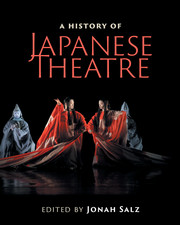Book contents
- Frontmatter
- Contents
- List of figures
- List of tables
- Contributors
- Contributors’ biographies
- Foreword
- Acknowledgments
- Note on Japanese terms
- List of abbreviations
- Timeline
- Editor's introduction
- I Traditional theatres
- Preface to Part I Japanese civilization arises
- II Modern theatres
- Preface to Part II
- III Arcs and patterns
- IV Theatre architecture
- Preface to Part IV Evolution of Japanese theatre architecture
- 16 Premodern patterns of spectatorship and space
- 17 Modernization of theatrical space, 1868–1940
- 18 Postwar theatres: development and diversifi cation
- Interlude National theatres and funding
- V Theatre criticism
- VI Intercultural influences
- Epilogue: Frozen words and mythology
- Further reading
- Index
- References
Interlude National theatres and funding
from Preface to Part IV Evolution of Japanese theatre architecture
Published online by Cambridge University Press: 05 July 2016
- Frontmatter
- Contents
- List of figures
- List of tables
- Contributors
- Contributors’ biographies
- Foreword
- Acknowledgments
- Note on Japanese terms
- List of abbreviations
- Timeline
- Editor's introduction
- I Traditional theatres
- Preface to Part I Japanese civilization arises
- II Modern theatres
- Preface to Part II
- III Arcs and patterns
- IV Theatre architecture
- Preface to Part IV Evolution of Japanese theatre architecture
- 16 Premodern patterns of spectatorship and space
- 17 Modernization of theatrical space, 1868–1940
- 18 Postwar theatres: development and diversifi cation
- Interlude National theatres and funding
- V Theatre criticism
- VI Intercultural influences
- Epilogue: Frozen words and mythology
- Further reading
- Index
- References
Summary
The architecturally striking, even monumental, national theatre buildings in Tokyo, Osaka, and Okinawa manifest Japan's highly developed, government-administered infrastructure of support and promotion of the arts. The principal manager of that infrastructure is the Agency for Cultural Affairs (Bunkachō), established in 1968 within what is now called the Ministry of Education, Culture, Sports, Science and Technology. One of the Agency's responsibilities is to carry out the Law for the Protection of Cultural Properties. It also oversees several independent administrative institutions, the semi-autonomous, publicly funded units that carry out the operational functions of the Japanese government. One is the Japan Arts Council, the executive body for the national theatres. The Japan Foundation, with which the Agency sometimes vies in sponsoring cultural exchange tours abroad, is an independent administrative institution under the Ministry of Foreign Affairs.
Six national theatres
Japan's first National Theatre, with its sweeping view of the Imperial Palace grounds at the center of Tokyo, opened in 1966. A burgeoning economy and a growing sense of national pride found expression in public affirmations of Japanese culture; over time, five more national theatres have been constructed – three in Tokyo and one each in Osaka and Okinawa. Collectively, they aim “to preserve and promote traditional performing arts, and to promote and popularize modern performing arts in Japan.”
They provide wide public access to the performing arts: ticket prices can be more than 50 percent lower than at commercial theatres. It is possible to see kabuki at the National Theatre for only 1,500 yen (US $15), while the best seat in the house usually costs no more than 12,000 yen (US $120). In contrast, at Shōchiku's newly reopened Kabuki-za theatre, also in Tokyo, the range for kabuki is generally between 4,000 and 20,000 yen.
To ensure a reliable pool of new, professionally qualified performers and production specialists, the national theatres offer training programs to young adults (only males in the traditional arts) selected through a public application process. Graduates of traditional performing arts courses then typically apprentice within the iemoto system, although such institutional training has been criticized as arbitrary and incomplete (see Interlude, p. 99).
Considerable energy goes into cultivating new audiences. “Appreciation classrooms” aimed mainly at schoolchildren include lively lecture-demonstrations and a sampling of professionally staged dramas.
- Type
- Chapter
- Information
- A History of Japanese Theatre , pp. 437 - 440Publisher: Cambridge University PressPrint publication year: 2016
References
- 1
- Cited by

